Swedish sled hockey player Amanda Ahrnbom arrived at the 2006 Torino Paralympics aiming to represent her country. Instead, she was ruled ineligible by the International Paralympic Committee (IPC) during team processing after the organization learned she was a woman.
“I don’t think it is right and I am disappointed,” Ahrnbom said in 2006.
Ahrnbom was allowed to remain in the village and compete in a pre-Paralympic game between the U.S. and Sweden – which was ironically held on International Women’s Day. As for the actual Paralympic sled hockey tournament, she was relegated to the bench, serving as the de-facto cheerleader.
“It’s really very unfortunate for Amanda. There was a misunderstanding on the part of both parties,” then IPC spokeswoman Miriam Wilkens said in 2006.
Sled Hockey: A mixed gender sport that isn’t usually mixed gender
When sled hockey (also known as sledge hockey or para ice hockey) debuted at the 1994 Lillehammer Paralympics, it was a mixed gender sport. One woman – Norway’s Britt Mjaasund Oyen – competed in the inaugural tournament. At some point in the late 1990s or early 2000s (the exact year is unclear), the sport switched to being open only to men – thus leading to Ahrnbom’s exclusion when she arrived in Italy in 2006.
The incident in Torino sparked sled hockey being switched back to mixed gender status ahead of the 2010 Vancouver Paralympics. But it wasn’t until 2018 that a second woman – Norway’s Lena Schroeder – broke through to compete at the Paralympics.
In Beijing, a third woman – China’s Yu Jing – made her Paralympic debut. She didn’t touch the ice in five of six games, including China’s 4-0 bronze-medal win on Saturday. But she did get a few minutes of ice time in a 6-0 win over Italy on Tuesday, which – coincidentally or not – was on International Women’s Day.
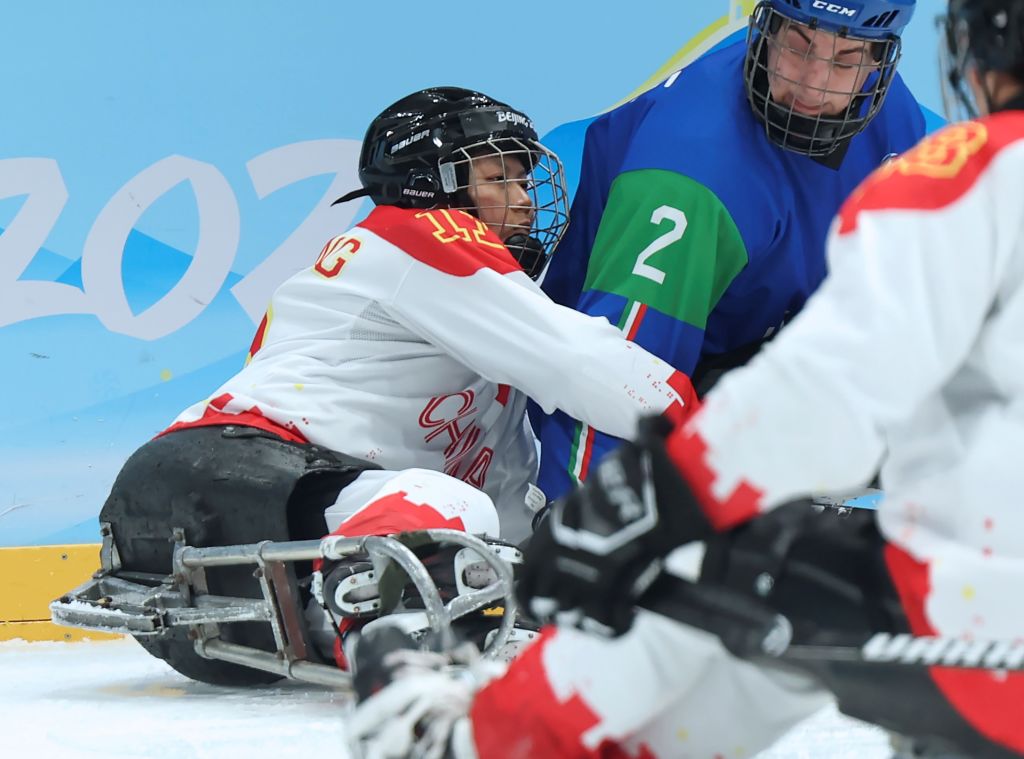
“My debut at the Paralympic Winter Games is my gift to myself on this International Women’s Day,” said Yu, who started playing sled hockey two-and-a-half years ago. “I hope that women out there will see my debut and believe that there is a chance for them to be on the same stage. Disabled women all over the world, I hope they know it’s not impossible, and I hope they see this as encouragement.”
World Para Hockey celebrated Yu Jing’s achievement on Twitter, using the International Women’s Day hashtag. But nearly 6,000 miles away, U.S. sled hockey player Kelsey DiClaudio struggled with the message she was seeing.
“Having only 3 female athletes participate in the games since 1994 is quite sad,” DiClaudio wrote on Twitter. “Internationally, para ice hockey is not a mixed event. Many countries don’t consider their female players for national teams.”
DiClaudio, who started playing sled hockey at age 9, knows that her belief in herself is not what is holding her back from competing at the Paralympic Games.
“Since 2010, when I watched the Vancouver Paralympic Games, it became my dream from that point on that I wanted to get to the Paralympics,” the 24-year-old told On Her Turf. “My goal was to make the men’s national team. That was the only goal I had, it was tunnel vision. And I was told, ‘We have a spot open for a girl, if she’s good enough.’”
The question of whether DiClaudio is “good enough” isn’t really the right one to ask, though many of her teammates insist that she is. Instead, it is whether DiClaudio and other female sled hockey players are set up for success in a so-called mixed gender sport.
The answer there is a resounding ‘no.’
“The reality is that you are still running a men’s tournament and it’s being disguised as a mixed gender tournament,” said Tara Chisholm, head coach of the Canadian women’s ice sledge hockey team.
Is sled hockey’s ‘mixed gender’ label doing more harm than good?
In addition to having the “mixed gender” label, sled hockey also features a perplexing rule that – while perhaps well intentioned – has been ineffective at best and harmful at worst. While men’s-only teams max out at 17 players, rosters are allowed to expand to 18 athletes if a woman is included.
“That rule, in theory, was attempting to be more inclusive towards women. In reality, it’s actually really inhibited the development of women’s para ice hockey because the argument has always been, ‘Well, there is a place for them. They just haven’t broken (onto) the roster yet.’ And in a full-contact sport, that’s a lot to ask,” said Peggy Assinck, who has been a member of the Canadian women’s team since it formed in 2007.
“It’s like someone dangling a dollar in front of your face and saying that, ‘You’ve worked this hard, you’re going to get it,’ and then getting it taking it away,” DiClaudio said of the potential 18th roster spot. “I did have a lot of hope that I would make the team. But as the years went on, it kind of dwindled more and more.”
DiClaudio isn’t alone.
“The number of times that women have had the dream of rostering to the men’s Canadian national team, and were told flat out by national team coaches, that there was no chance of that ever happening, just happened over and over and over again,” said Assinck. “It basically depleted those dreams.”
While Assinck believes the “mixed gender” label might be helpful in nations where the sport is still developing – like China or Norway – for powerhouses like the U.S. and Canada, it is instead serving as a barrier.
As a result, in recent years, many members of the women’s sled hockey community have shifted their focus from trying to break onto men’s rosters to dedicating their energy to developing the women’s game.
Doing so would help even the playing field at the Winter Paralympics, where the gender disparity still skews heavily male. Of the 564 athletes competing in Beijing, only 138 (24%) are women. While sled hockey is not the only winter Paralympic sport with a wide gender gap, the fact that 117 out of 118 sled hockey athletes in 2022 are men plays a large role in tipping the scales.
The creation of the U.S. women’s sled hockey team
Shortly after Ahrnbom was nixed from Sweden’s Paralympic roster in 2006, a U.S. player received a similar message.
Erica Mitchell (now McKee) made the U.S. men’s junior team in 2004, and in 2006, she was named captain of the roster, becoming the first – and only – woman to serve in that role.
Mitchell was talented enough to be in the mix for a roster spot on the U.S. senior national team. But ahead of a selection event in 2007, she was told that while she was allowed to tryout, she wouldn’t be allowed to make the team because she was a woman.
“My heart sank and I just started crying uncontrollably, I had never in my life been segregated from the sport that I love because I was a female,” Mitchell recounted to Think Progress in 2018.
The impact that Mitchell sparked with her anger and frustration cannot be understated.
“She literally created the women’s team,” said Monica Quimby, who has been a member of said team since 2014. “Erica was told to basically make her own team, and that’s exactly what she did.”
With the help of “the Toms” – Tom Koester and Tom Brake – the U.S. women’s sled hockey team was founded in 2007, and in May of that year, the first-ever women’s sled hockey game was played. Two current national team players – Mitchell from the United States and Assinck from Canada – took part in that inaugural game, though country lines got a little blurred.
“There were not enough women on the USA team, so I actually wore a USA jersey for that first game,” Assinck explains.
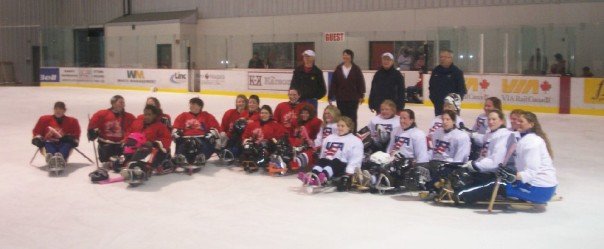
In the years that followed, both the U.S. and Canadian women’s hockey teams continued to develop. In that first decade, both teams were self-funded and operated, existing outside of their respective national governing bodies. In the U.S., “the Toms” funded the women’s sled hockey team.
“Without their support, we wouldn’t have been able to have the growth, the expansion, the amount of camps,” Quimby said.
While the Canadian team continues to operate independently of Hockey Canada to this day, in 2018, the U.S. women’s sled hockey team was taken under the umbrella of USA Hockey.
The shift came with a name change, with the U.S. women’s sled hockey team rebranded as the U.S. women’s development sled hockey team.
Female players are now siloed under the development wing of USA Hockey, along with the men’s development team. At the same time, the U.S. national sled hockey team has remained without a gender modifier. But in actuality, it is a coed team in name only. No woman has ever made the U.S. sled hockey team at the senior national level.
Quimby says the move was bittersweet. “We saw it as a step forward towards the Paralympics – the ultimate goal.”
But it has also resulted in fewer playing opportunities. Under the Toms, “We were having seven or eight camps (a year), and multiple international trips,” Quimby said. “Now, we’re only having three or four camps.”
On Her Turf reached out to USA Hockey about the organization’s goals for women’s sled hockey at the domestic and international level, but did not receive a response prior to publication.
For Maddy Eberhard, the move to USA Hockey also marked the start of a dark chapter. In June 2020, she publicly accused a male player and a male executive at USA Hockey of sexual harassment in a story published by The Athletic.
Eberhard wasn’t sure if she wanted to keep playing, but ultimately, the support of her teammates motivated her to continue. “They’re all sisters of mine and I know I can reach out to them with anything that I have going on, whether that be hockey related or not,” she said.
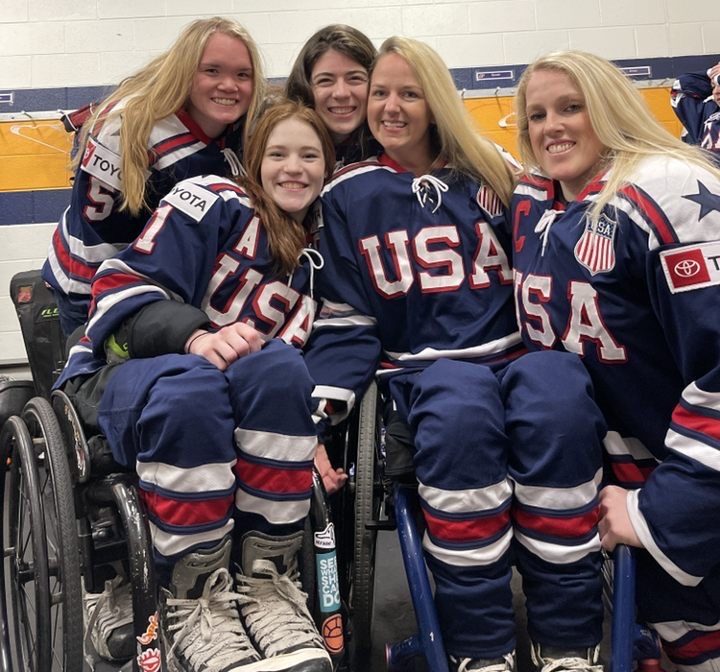
Is it any surprise that a USA-Canada rivalry extends to women’s sled hockey?
During last month’s Winter Olympics, the Toronto Star published a column arguing that women’s hockey doesn’t belong in the Olympics because the U.S. and Canada are too dominant. The article resulted in what was perhaps the most unified moment in recent women’s hockey history, with players, coaches and fans coming together to condemn the bad take.
And yet, the dominance of only two teams – the U.S. and Canada – is the reason women’s sled hockey is not currently on the Paralympic program.
“What is holding us back is the lack of international teams,” Assinck said.
It is for that reason that Tara Chisholm, the head coach of Canada’s women’s sled hockey team (a volunteer position), spends a surprising amount of time not actually focused on team Canada.
Chisholm, who lives in Medicine Hat, Alberta, splits her time working eight different positions (five paid, three in a volunteer capacity) – all in the adaptive sports realm.
Over the years, she has developed contacts in 14 nations and counting – from Australia to Japan to Armenia – with the goal of growing women’s hockey internationally. Chisholm leads zoom calls and other workshops to pass along any coaching resources and tips she can. Whenever the Canadian team travels to international events, the players bring donated equipment with them.
“It’s kind of just all hands on deck, trying to do whatever we can to grow the sport,” she said.
While Chisholm’s work is certainly making an impact, it is not entirely altruistic.
As DiClaudio puts it: “Unfortunately, the U.S. and Canada are such big powerhouses in the sport… No matter how much we grow, if the other countries aren’t growing, we can’t get to the Paralympic Games.”
Assinck, who has been a member of the Canadian team since that inaugural 2007 game, has also taken that commitment of growing the game internationally to heart.
After completing her PhD in Neuroscience at the University of British Columbia in 2017, she moved to Great Britain to become a postdoctoral fellow at the University of Edinburgh.
“It became kind of clear to me that, since I was here, I should probably be doing more to help develop women’s sled hockey,” she says.
While most sports paused at the start of the COVID-19 pandemic, Assinck instead used the time to recruit a national team player pool. She created a social media campaign, which was amplified by World Para Ice Hockey, local para sport organizations, as well as Channel 4, which broadcasts the Paralympics in United Kingdom.
Over 60 women expressed interest and 27 were ultimately selected for the first camp.
And then came the challenge of equipping the players. “We spent a huge amount of money to ship (equipment) from Canada to the UK to my living room,” Assinck says.
After more than a year of planning, at 11pm on a Friday night in October, the players and volunteer staff convened at Planet Ice Widnes – a rink midway between Liverpool and Manchester – for their first on-ice session. A representative from the IPC was even there.
“It was absolutely amazing,” said Assinck, who has also served as an assistant coach of Great Britain’s men’s team. “(The players) are quite aware that they’re at a development phase compared to Canada and USA… But they’re also excited to be trailblazers.”
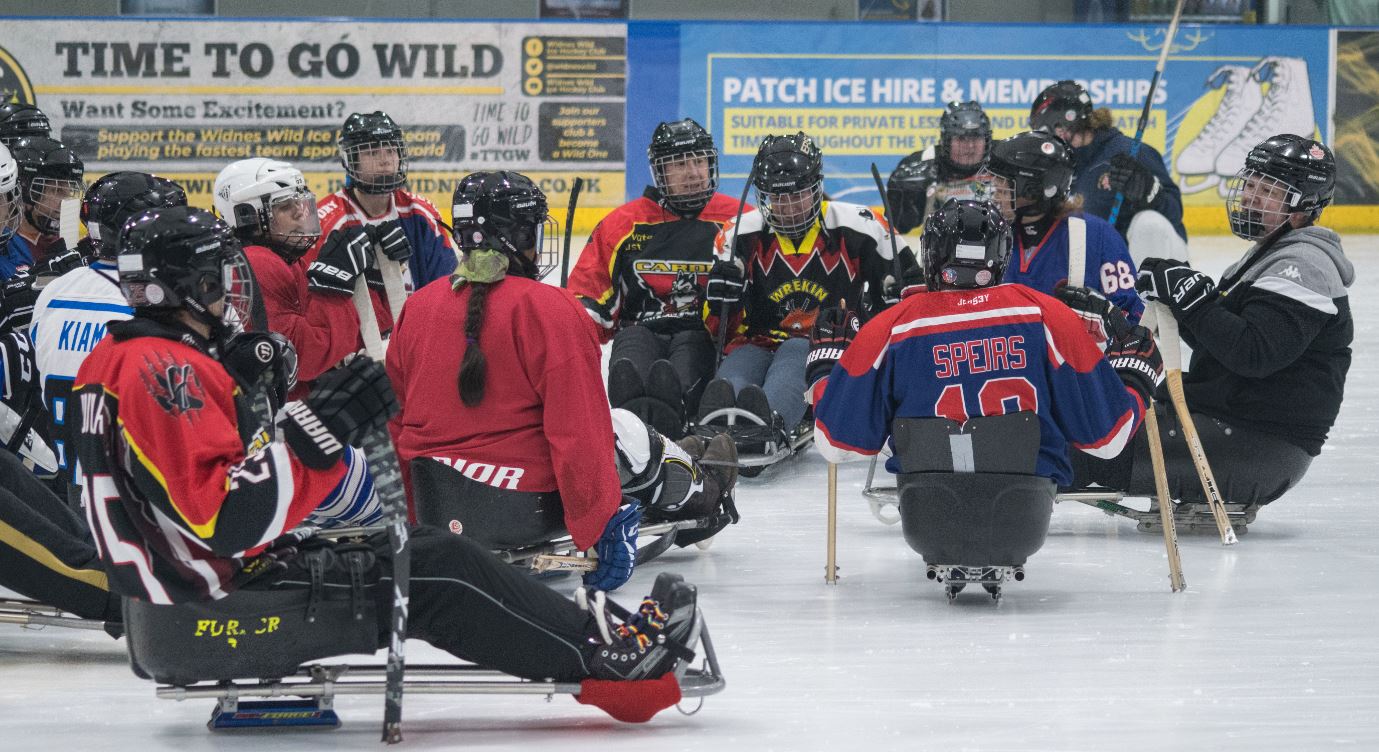
In the near-term, funding remains a major barrier. While Assinck and other volunteers paid for the first camp out-of-pocket, players will be responsible for paying their own way to compete at future tournaments and camps, which is a burden Assinck is familiar with first-hand.
Because Canada’s team operates independently from Hockey Canada, the team gets by on fundraising and player fees, with coaches and staff serving in a volunteer capacity. Since that inaugural game in 2007, Assinck estimates that she’s spent about $5,000 a year to get herself to camps and tournaments, a decision that has caused her to go into debt.
“I have just comfortably gone into debt because (this sport) meant so much to me, but that’s not a reality for most women. That’s not a reality for most women with disabilities,” she said. “A lot of women have decided that playing para ice hockey couldn’t be a priority, financially.”
With no timeline for Paralympic inclusion, some female sled hockey players have also opted to pursue other sports.
At the 2022 Beijing Winter Games, Canadian Christina Picton and American Lera Doederlein – considered two of the best female sled hockey players in the world – are instead making their Paralympic debuts in nordic skiing.
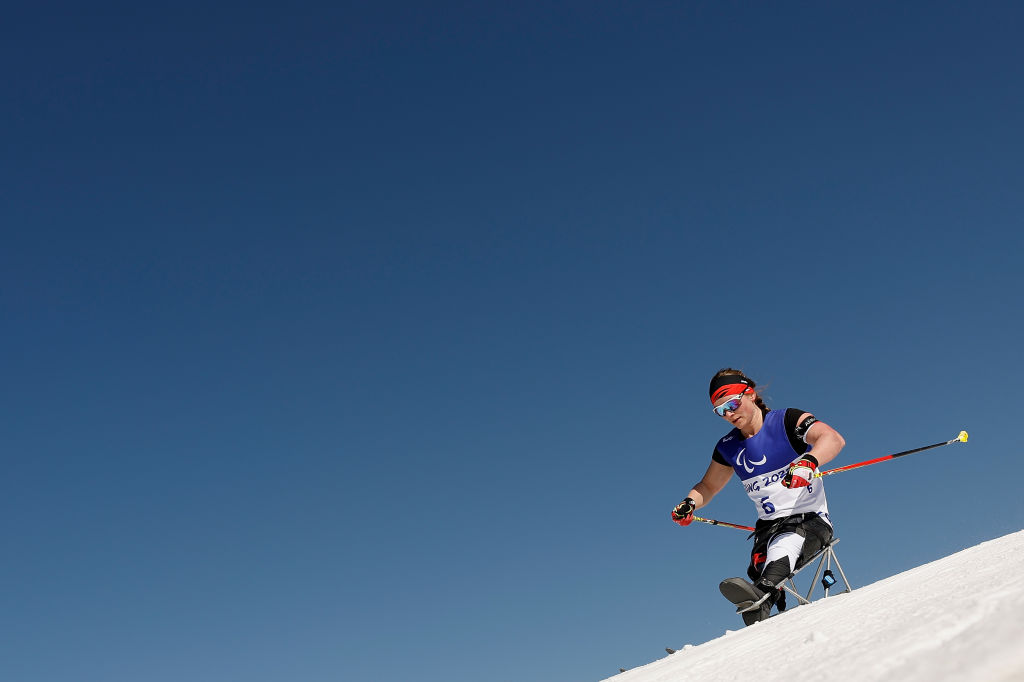
“That was always the dream to be here as well for para ice hockey, but I’m so fortunate to be on the para Nordic skiing team and to be surrounded and training with excellent coaches and amazing athletes I’m so, so lucky to be here with this crew,” Picton said on Friday after finishing seventh in the women’s individual biathlon sitting competition.
A circular problem with no single solution
Despite the grassroots efforts to grow women’s sled hockey, the future remains unclear. And for players who have been involved for over a decade, the soundtrack is getting old.
“They keep saying ‘Four more years, four more years, four more years,” Quimby said. “(Let’s) create a plan, a concrete timeline, and move towards that… Saying ‘four more years’ every four years is not going to get us where we need to go.”
Assinck, 38, gets it. “As a young girl, I remember the dialogue being, ‘Soon we’re going to be in the Paralympics.’ … And obviously that hasn’t yet come to fruition.
“It’s a circular problem. If we were in the Paralympics, everyone would create a team. But because we’re not, nobody’s creating a team. And unfortunately, that’s a really tough cycle to be kind of stuck in.”
It’s the type of problem that needs to be solved using concurrent approaches: a team of dedicated and passionate grassroots personnel who are, in turn, supported by top-down initiatives.
In 2014, World Para Ice Hockey launched a women’s program thanks to a grant from the Agitos Foundation, a funding initiative program run by the International Paralympic Committee (IPC). A spokesperson for World Para Ice Hockey said a number of additional grants have helped fund both female-only and mixed team training camps since.
But Taylor Lipsett, a three-time Paralympic sled hockey medalist for the U.S. who is serving as an analyst for NBC during the 2022 Winter Paralympics, believes more support is needed.
Unlike at the Olympics, where sport federations are governed by – but operate independently from – the International Olympic Committee, the International Paralympic Committee serves as the governing body for five of six winter Paralympic sports (all but wheelchair curling, which is overseen by the World Curling Federation).
“The IPC has to take charge. They’re responsible for governing the sport, and I don’t think they’ve done a great job on the women’s side,” Lipsett said. “It’s their responsibility to invest in various European countries, Asian countries to develop the women’s game, and they haven’t done that.”
While both the International Paralympic Committee and International Olympic Committee have discontinued the use of demonstration events since the 1990s, Lipsett thinks that model could help women’s sled hockey.
“I see no reason why it couldn’t (have been) in Beijing as a demonstration sport,” he said. “That would be a huge thing for the development of women’s sled hockey. But someone has to make that decision to allow that, to make that happen.”
Later this year, World Para Ice Hockey plans to hold a Women’s World Challenge tournament, with three to five teams expected to compete.
But the dates and host city haven’t yet been announced, and while that might not sound like a big deal, Chisholm says the absence of a consistent schedule and advance notice has impacted the growth of the game internationally.
“That is actually one of our biggest barriers. Women would train and they wouldn’t know what they were training for,” she said.
“One of the things that we’ve asked is to have (an event) every year at the same time… (That way) when I’m talking to other nations, I can say, ‘Hey, this is happening. Start planning for it. And what can we do to support you to get there?’”
Looking further ahead, a spokesperson for World Para Ice Hockey said via email that the organization does not currently have a specific timeline for the inclusion of women’s sled hockey at the Winter Paralympics.
“I can’t lie. It’s definitely hard,” said Katie Ladlie, a member of the U.S. women’s sled hockey team since 2015. “I have those days where I think, ‘How long is this going to take? How many times are we going to be told something and then the rug is going to be taken out from under us again?’”
With the Paralympics out of reach for now, the thing that keeps these women motivated is the same as what has powered female athletes in nearly every sport: the next generation.
“A lot of my energy and my focus and time is geared not only to my dreams, but women’s sled hockey in general,” DiClaudio said. “I just love (the sport) so much that I can’t leave at this point. If it’s my burden to bear, to play this sport and help grow it, I’m ok with that.”
ALSO FROM ON HER TURF: Women starred at 2022 Winter Olympics, but men photographed most of the action
Follow Alex Azzi on Twitter @AlexAzziNBC
Reference-onherturf.nbcsports.com